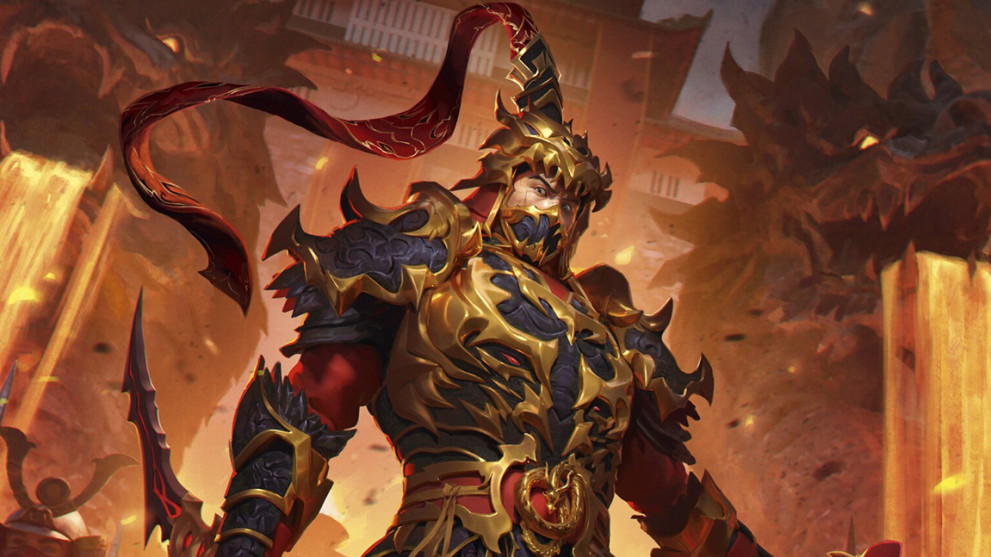In these final days before The Hunted releases, I'm finding more and more that my excitement for the set is concentrated on Fang. Cindra is a compelling new addition to the wide variety found among Ninjas, but I'm probably more excited to return to Fai after a long hiatus, while Zen and Ira will also enjoy the gains from HNT. As for Arakni, this latest take will surely pull some portion of Assassin players away from Nuu and add much-needed variety to the class, while also injecting Uzuri with fresh tools.
With Fang, the situation is different. Warrior has struggled with relevance ever since Part the Mistveil shifted the game away from Heavy Hitters' value-based meta. But even before that shift, Warrior was struggling with being 'a little too fair'. Cindra and Arakni are exciting new contenders looking to faction off their classes' player bases; Fang is trying to put Warrior back on the map.
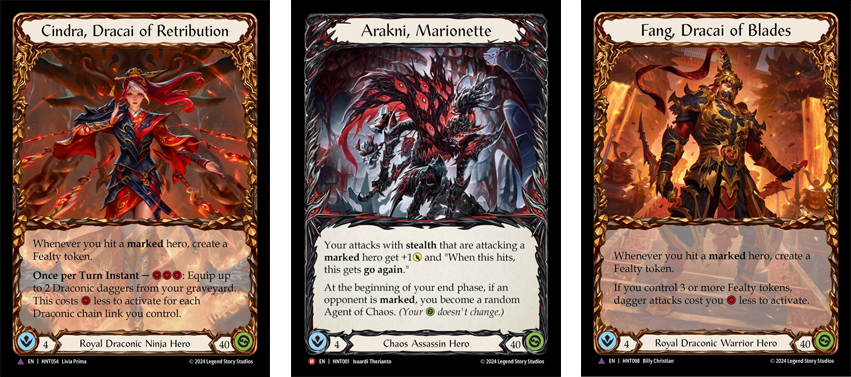
To be clear, I think all Warriors are going to see improvements thanks to The Hunted. The core Warrior class was given a suite of highly relevant majestics that are weapon-agnostic, including a long-awaited answer to Enigma's damage prevention. For the Dorinthea faithful, these new tools offer a re-entry point to the meta - though they're probably not enough to inspire many new recruits. Similarly, Kassai now has answers to some of the questions that were plaguing her. Boltyn's continued to defy the odds with a loyal following able to get more out of him than seems possible, and he in particular received an additional expansion slot card that's certain to make every list going forward. This leaves only Olympia wondering what he should be doing; if the next set features Gold, I expect him to finally find a place - only to immediately take a seat behind an ascendant Kassai.
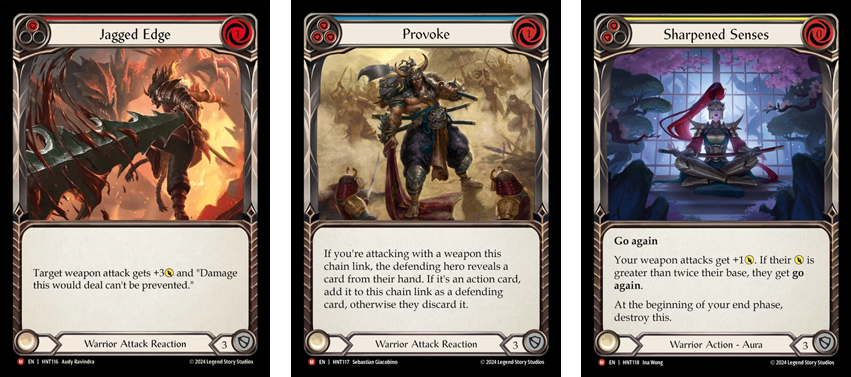
But as I consider our first Dagger Warrior, I can't help but think that Fang is doing a profoundly new thing here, and it may unlock dynamics the class has never explored before. This is only the second dagger to join the Warrior's extensive weapons cache, and while these 1-damage weapons may feel like downgrades from Cintari Sabers, the accompanying support for the weapon-type adds nuance that's worth discussing.
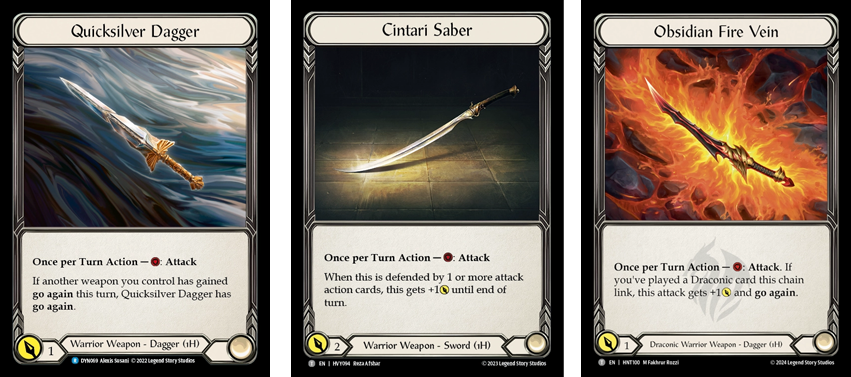
Melee Mathematics
One of FAB's strongest assets is its rigorous adherence to the math that underlies the game system. Many classes find ways to cheat the numbers as their core way to gain advantage - but seldom are weapons allowed to bend the cost-to-value ratio. That's because a hero's weapon is the one attack always available to them; if it was above rate or even on-par with other options, it would quickly become the optimal play each and every turn.
And yet this is precisely Warrior's core concept: attack with the weapon every turn. In support of that concept, the Warrior card suite is full of modifications to your weapon, both before and after you've made your attack. Though non-attack actions and attack reactions, Warrior gameplay comes alive - but it's all built upon the weapon.
Before The Hunted, we've seen a few variables used to tie certain cards to certain weapons and maintain the balance. But the general variables are these:
- 2H Sword: costs 1, deals 3
- 2H Axe: costs 3, deals 3-4
- 1H Sword/Axe: costs 1, deals 2
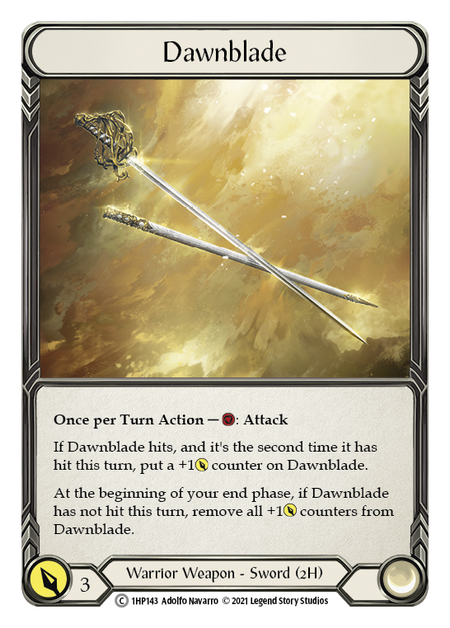
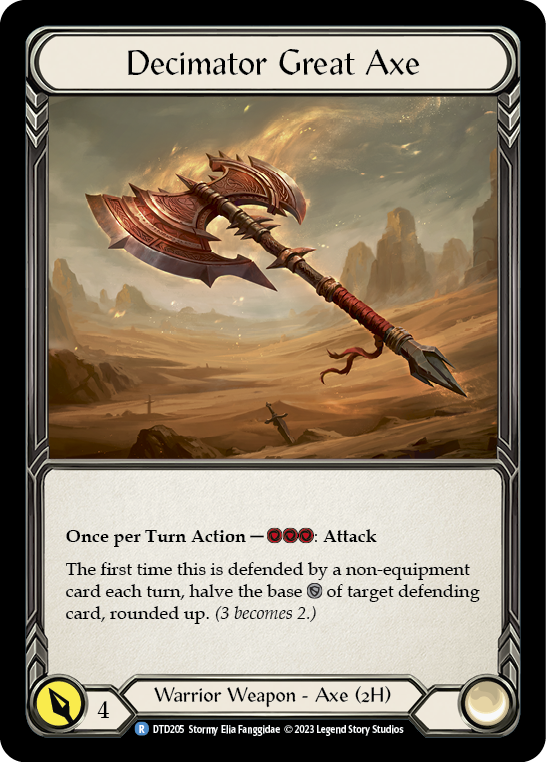
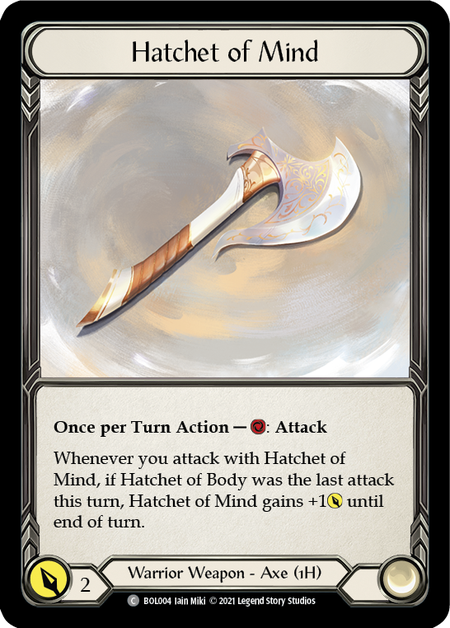
With those regulations in place, the weapons are allowed minor variation in the form of effects: a conditional +1 on a 2-damage weapon, or a conditional go again, or in the case of Dawnblade, the potential to continue accumulating +1s as long as you continue your hit streak. But everything is tied pretty rigidly to 3 - in fact, that holds pretty true across the entire class.
Predominantly, Warriors use two card types to buff their weapons: non-attack actions, and attack reactions. When discussing buffs, the non-attacks have a little more leeway, as they give information to your opponent up-front; still, at 0-cost, these cards tend to be locked at +3 for swords, as seen in the quintessential Sharpen Steel or more complex variants like Hit and Run , Outland Skirmish, and Unsheathed.
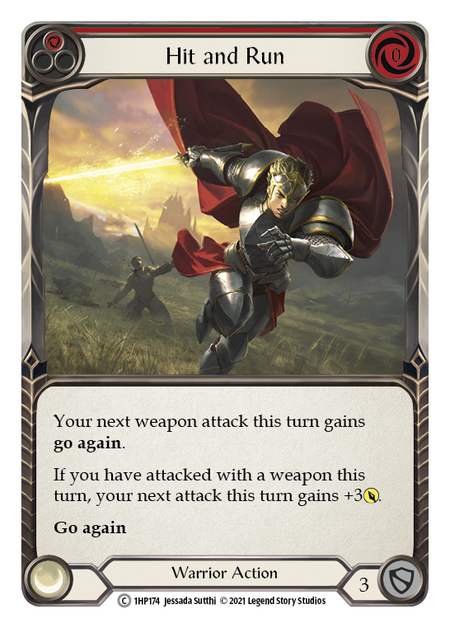
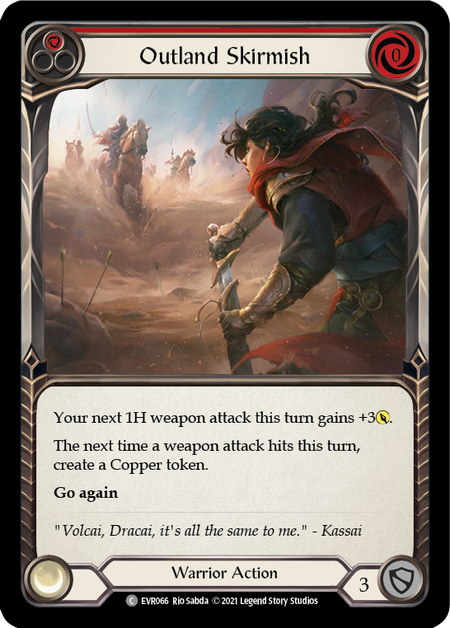
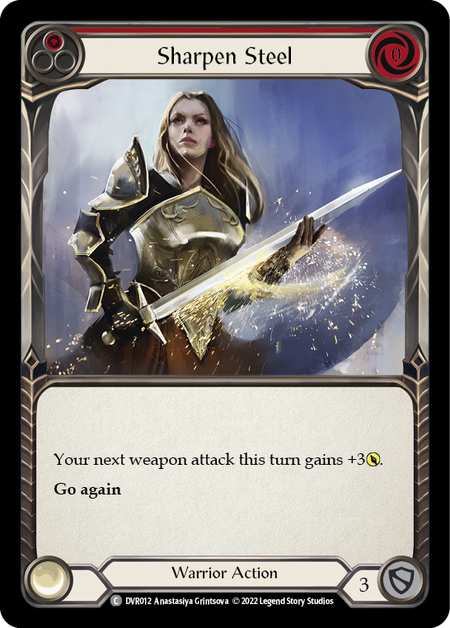
Even at 1 cost - a convenient price to pay with a blue when your goal is two weapon swings in a turn - this standard stubbornly persists. Typically, that 1 resource will get you a solid secondary effect, rather than extra damage. Commanding Performance gives your weapon a Command and Conquer-esque on-block, Warrior's Valor grants go again, and Push Forward gains dominate.
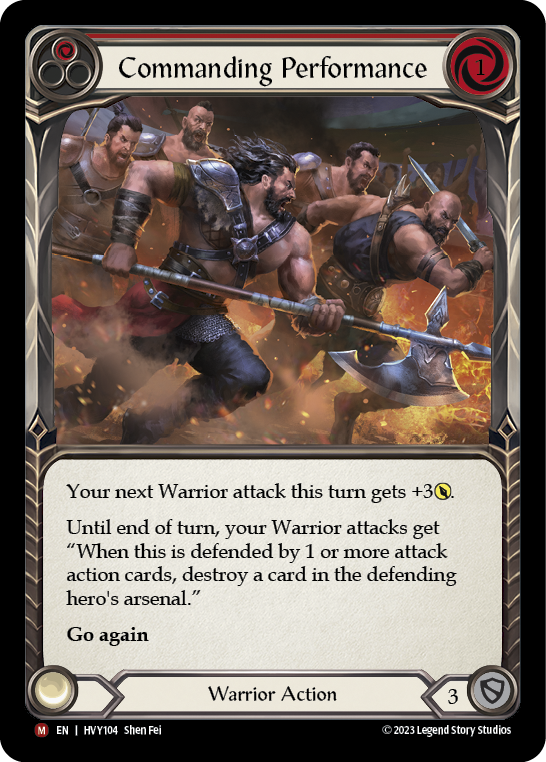

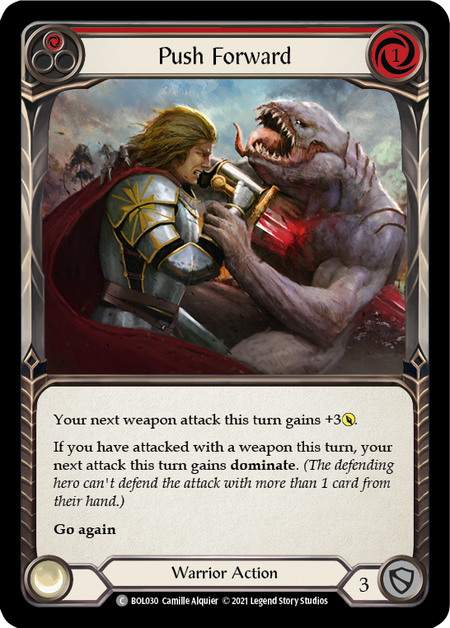
In fact, at 2- and 3-cost, the 3s remain. Felling Swing offers a massive +6 at red, but it costs a full 3 resources and limits you to using axes.
There are two occasions when this rule of 3 is broken on non-attack actions. The first is straightforward: the damage is the secondary effect. Cleave may have some text about dealing equal damage to an ally, but in most cases there won't be a second target, and that +4 represents the full value. Similarly, Plow Through only gets +4 when your opponent blocks with the wrong type of card ("my opponent blocks me" is a common price in Warrior for better effects - but we'll revisit that later when we discuss reprise).
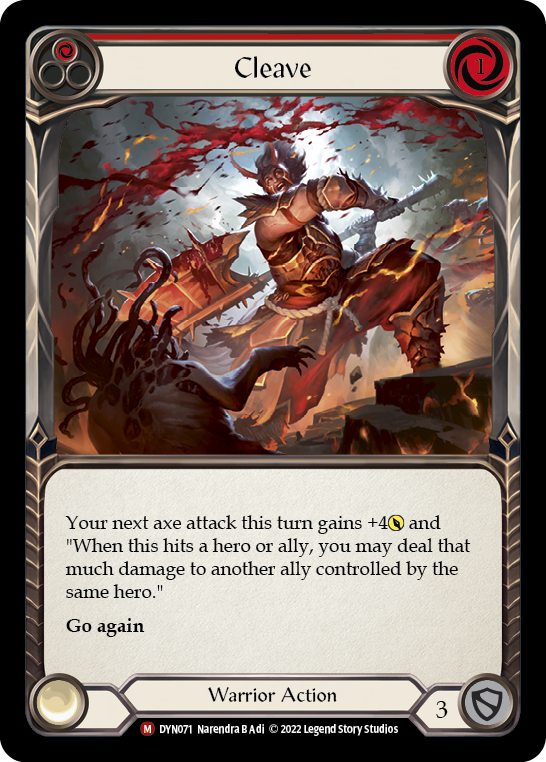
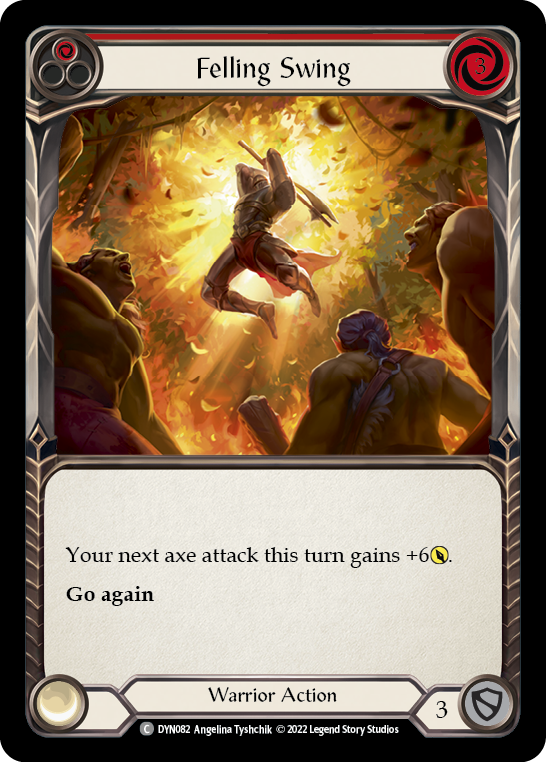

The second way that cards break the rule of 3 is by splitting the damage across multiple attacks. Slice and Dice (red) manages to give +4 at zero cost - so long as you can give your first weapon swing go again. Similarly, Second Swing (red) is a +4 that can only be used on the second attack. The infamous Steelblade Supremacy gives Dorinthea +2 to a single weapon for the whole turn, but it will need both go again and "you may attack an additional time with this weapon this turn" before it grants 4+ damage.
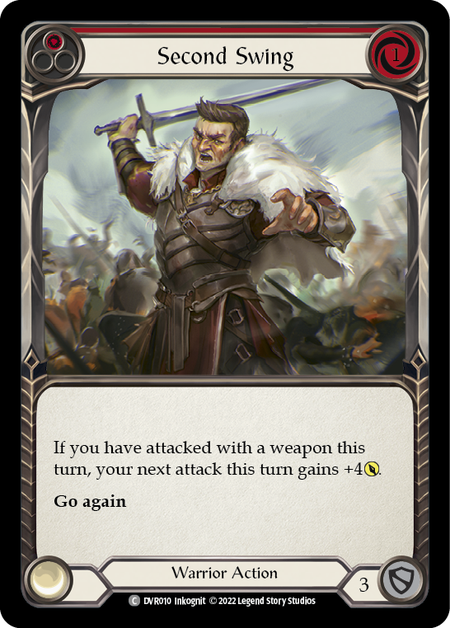
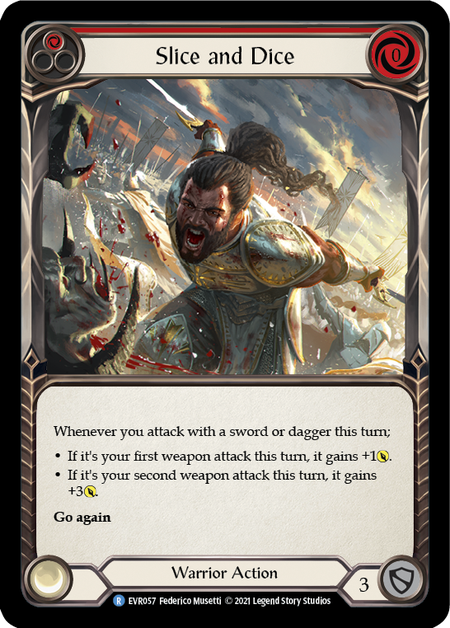
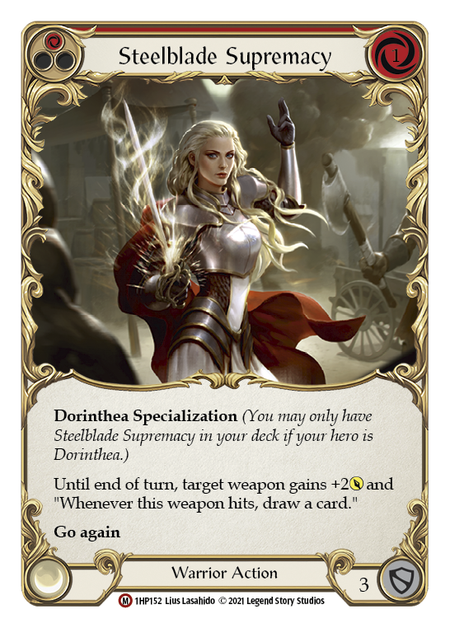
Attack reactions are held to even higher standards as we push at the boundaries of that rule of 3 we've come to expect. At 0-cost, In the Swing (red), Ironsong Response (red), and Take the Upper Hand (red) all manage to offer a full +3, but each come with high requirements: that it's your second weapon attack, that your opponent has blocked from hand, and that you've wagered on this attack, respectively.
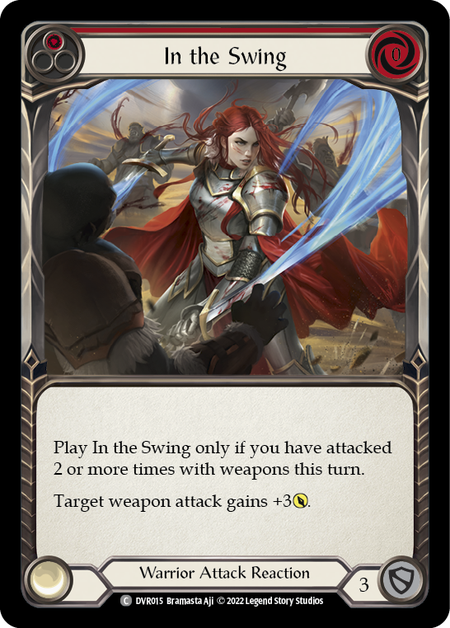
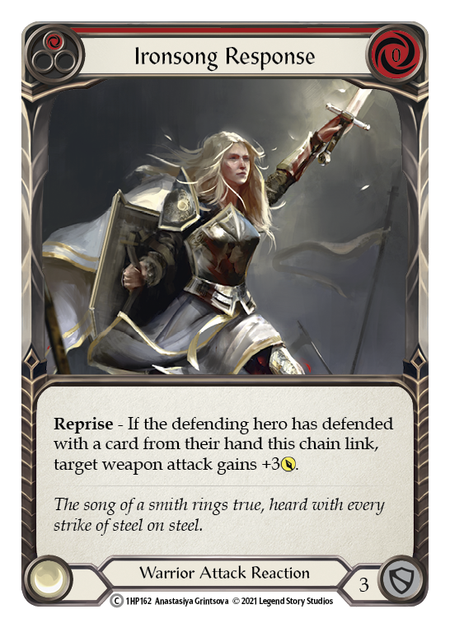
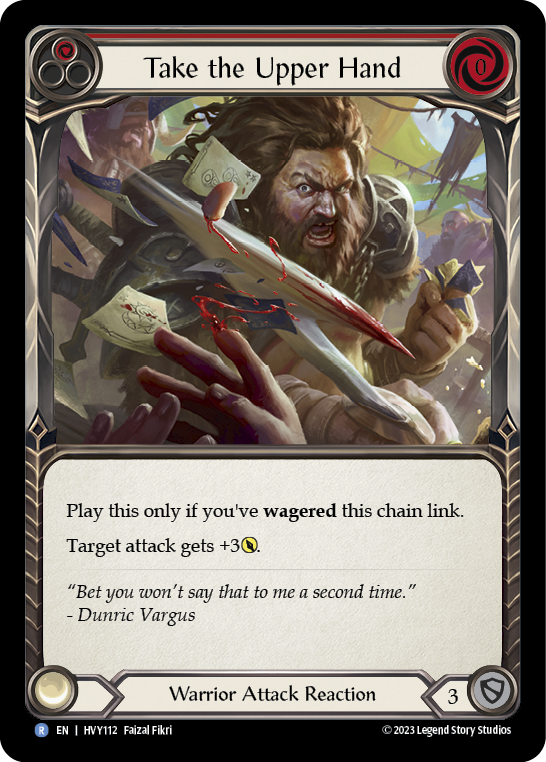
Reprise was used frequently in the early days of Warrior to allow the class to overcome the designed counterpoint to a class that plays at reaction speed; in this case, it's by far the easiest bar to clear. It shows up again to help Out for Blood (red) achieve a +4 (across 2 attacks), Biting Blade (red) give +4 (and +1 to future weapons this turn), Rout accomplish an effective +6 (or more) by sending back a defending card, and Overpower reach a +6 - though at red, it's already a +4 on its own.
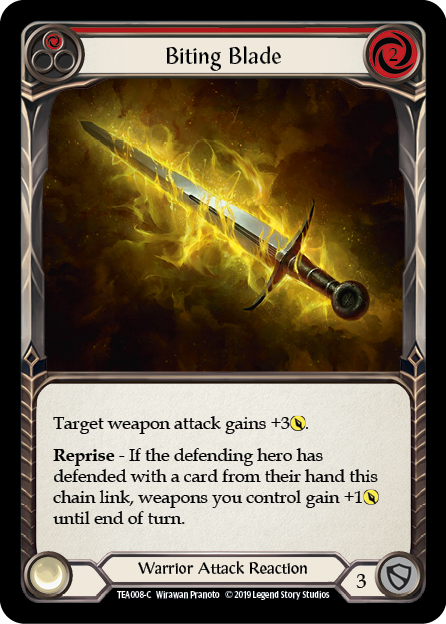
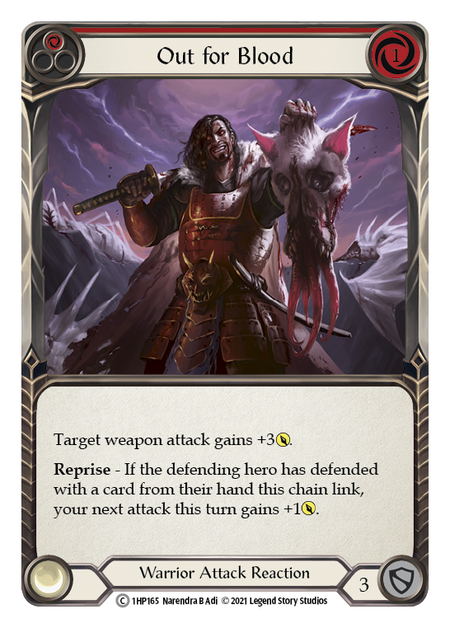
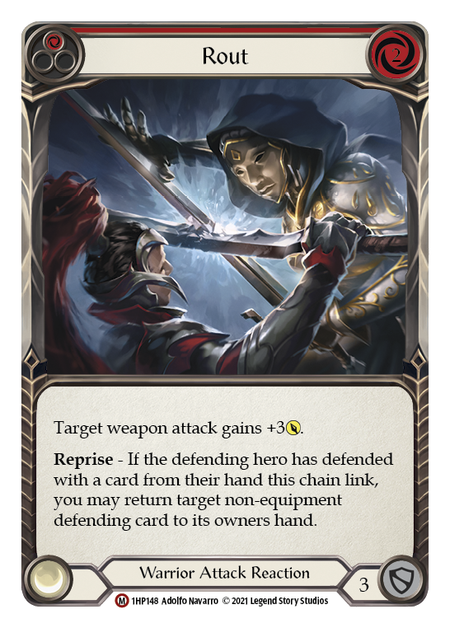
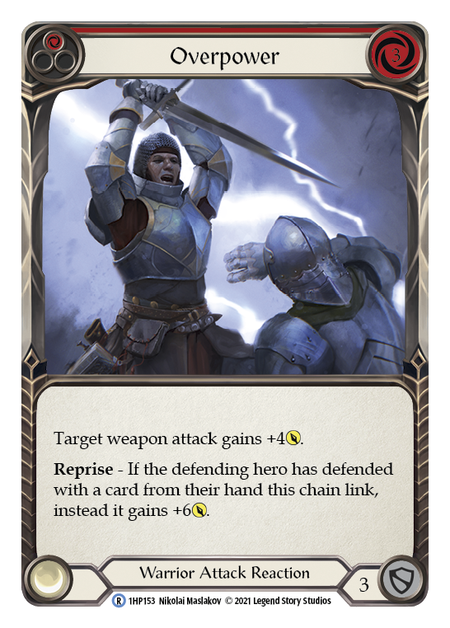
But beyond reprise, the options to react above a +3 are pretty slim. The 1-cost Puncture (red) gets to +4 if there's equipment on the defensive side. At 2-cost, Fatal Engagement (red) can give +5 when the opponent is defending with an attack action. Both of these rely on the opponent's choices to get value - they're effectively more highly restricted variations of reprise. Blade Flurry gives a +4, but across two attacks.
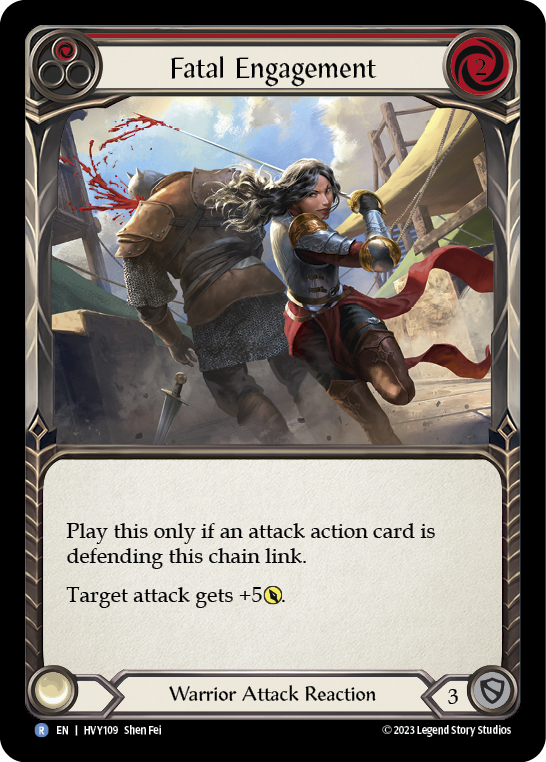
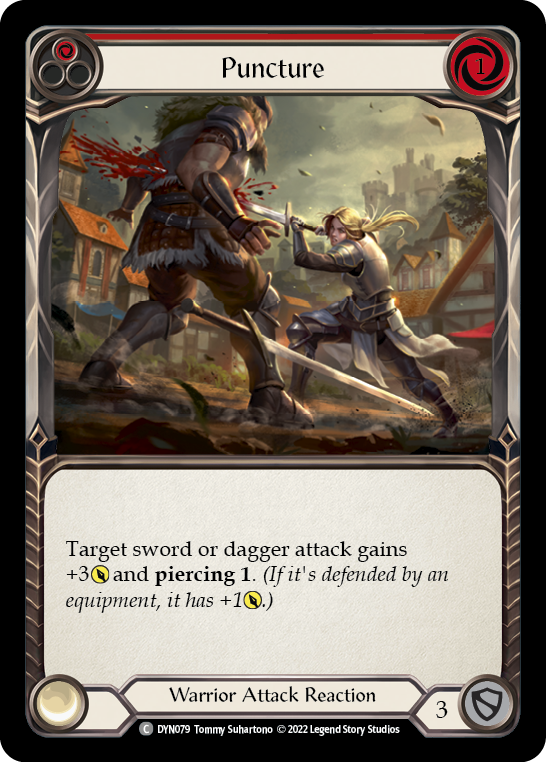
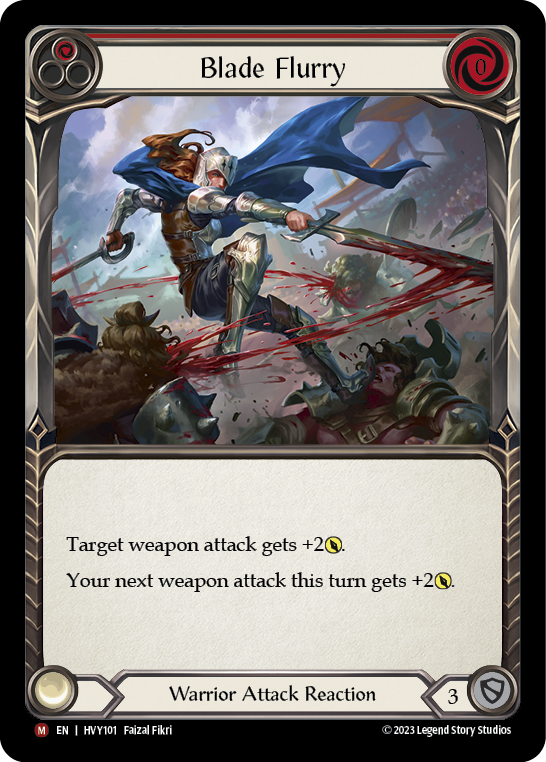
Despite the nature of the Warrior class as a reaction and buffs class, this puts us in a lamentably predictable spot: for each card in hand and each resource, we can assume the Warrior's weapon attack can climb by 3. And if we know their goal is to attack twice in a turn, their ability to operate outside of that schema on any given attack is relatively limited. Unblocked, the potential of a single sword swing looks about like this:
- 2H Sword with 2 floating and 3 in hand: 3 base [+3 reaction +3 reaction] = 9 (and 1 card left in hand)
- 2H Sword, buffed by a non-attack action, with 2 floating and 2 in hand: 3 base +3 buff [+3 reaction +3 reaction] = 12
- 1H Sword with 2 floating and 3 in hand: 2 base [+3 reaction +3 reaction] = 8 (and 1 card left in hand)
- 1H Sword, buffed by a non-attack action, with 2 floating and 2 in hand: 2 base +3 buff [+3 reaction +3 reaction] = 11
Of course, this is an oversimplification of the Warrior strategy. But at its core this is what you're staring down when a Warrior lines up that first swing. If you're looking to just tank and race, this is what's on offer - and for all the variation available between heroes, the core math of the class remains this, almost without exception: 4 cards makes 12.
Less is More
The Hunted is making space for Fang by, essentially, redoing the math. By shifting the focus of the class to daggers - which have a base damage of 1 for that same 1-resource cost - the non-attacks and reactions are free to raise the benchmark to 4, not 3. In essence, we've lost repeatable value on the weapon, but gained a higher threshold on the disposable cards' values. This aligns well with the more aggressive identity of the Draconic talent, but also gives the Warrior class on the whole a new strategic posture: with daggers, you can raise the ceiling and exert more pressure.
Beginning with non-attacks, you'll find Cut Deep, Cut from the Same Cloth, Savor Bloodshed, and Twist and Turn all offering unqualified +4s on your dagger attack. The math here is now 1 resource + 1 card = 5 attack.
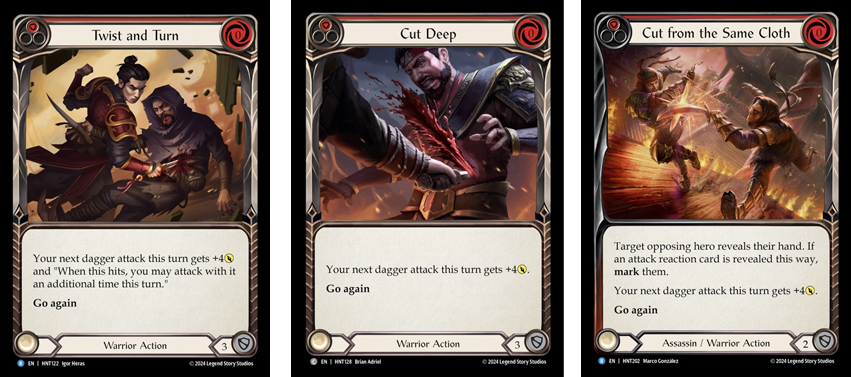
5 is lower than 6, of course, but by the time we've stacked 2 non-attack actions on our weapons, the dagger is now equal to any sword at 9. A third 0-cost buff, and the dagger has now reached 13, surpassing the math we've internalized for sword Warriors.
In addition to the above non-attack actions, the core Warrior card pool also gains 0-cost reactions like Diced, Incision, Scar Tissue, Take a Stab, and To the Point, all offering +3s.

Daggers don't get many reaction-speed +4s, and they're locked into the Draconic card pool - where Fang's signature weapons enhance their modifiers with their inherent +1 and go again from playing a Draconic card during their chain link. This allows Draconic cards to skip over the go again effects that Warriors so often rely on in favor of damage. The quick math there is:
- 1H Dagger with 2 floating and 3 in hand: 1 base [+3 Draconic reaction +1 from dagger +3 reaction] = 8 (and 1 card left in hand)
- 1H Dagger, buffed by a non-attack action, with 2 floating and 2 in hand: 1 base +4 buff [+3 Draconic reaction +1 from dagger +3 reaction] = 12
But if we pitched a blue, both of these lines of play end with 2 resources, which at minimum means a 2nd dagger swing (for 1). That's 9 and 13. And with optimized play such as not burning a 2nd Draconic reaction on the 1st dagger, we can reach 10 and 14. And this still floats 1 - meaning we could be pitching a yellow instead.
Fang, like Boltyn before him, is also more free to incorporate attack actions from his talent pool. So what if that last card in hand is an attack action? Just a simple For the Emperor - a 1 for 5 - raises the output for the first playline (optimized for 2 daggers) to 15 (the second line can't make use of the dagger optimally, so its output remains at 14).
Now imagine a turn with 3 Fealty tokens making Fang's daggers free. Opening with an Oath of Loyalty, you continue into an Obsidian Fire Vein + Blistering Blade, then your second Obsidian dagger + Hunt's End, and finish with the classic Lava Burst. That's 4 + 5 + 6 + 5 = 20 out of a 4-card hand, or 5 value per card - and none of it was contingent on your opponent's response.
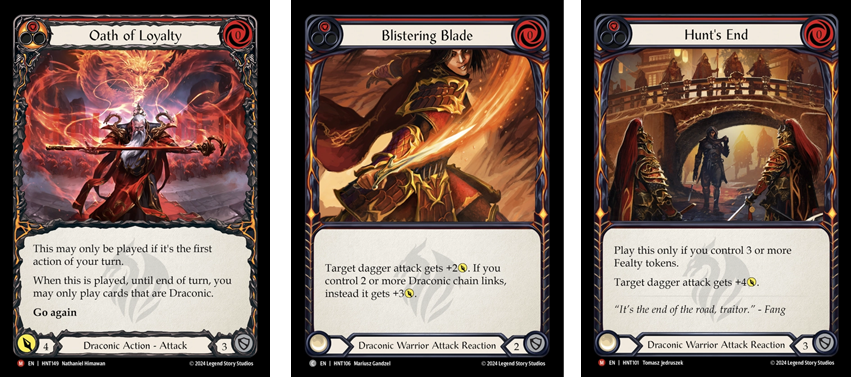
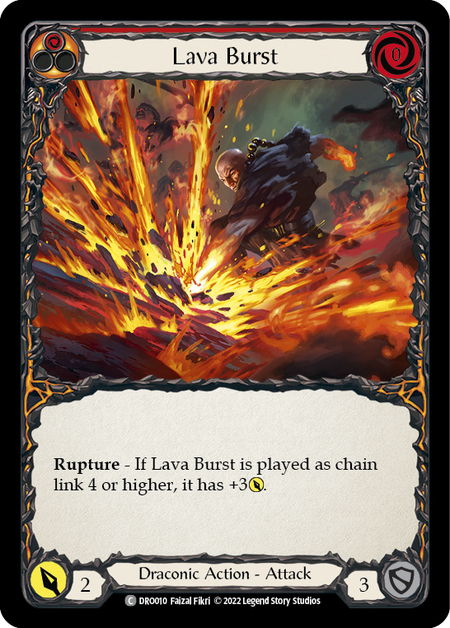
Now that's probably not a very likely scenario, and it's probably not even how Fang will be built. But the fact that it's possible shows the evolution of Warrior with Fang's debut. Prior to this set, Warrior has struggled to ever get significantly above 3 value out of any card, no matter if it's played, pitched, or blocked with. Fang has shifted that dynamic, increasing the value proposition in playing your cards at the cost of blocking value. This new, more aggressive posture for one of FAB's oldest classes is a welcome addition, and gives players greater odds of finding a hero that suits them within the Warrior class.
Will daggers go on to become an alternate build for other Warrior heroes? Without the Draconic talent, they're limited to the Quicksilver Dagger - a weapon with inherent go again, provided another weapon has gained go again already. This feels like it should have natural applications, but each of our existing heroes stumbles over a different limitation that leaves me skeptical. Dorinthea needs her first attack to hit so she can use the same weapon a second time - but to get max value out of the dagger, she'll need to run dagger-specific buffs that can't be used to aid her first weapon swing. Boltyn is typically fixated on the Light, disincentivizing the untalented dagger buffs. Kassai's sword attacks are free when she's drawn a card - but that dagger will still cost her 1. And Olympia's focus on wagering means he also wants to remain flexible on which attacks his cards can target. If I really wanted to push the dagger archetype onto an older hero, I'd probably start with the duo from Heavy Hitters, but realistically I think we're waiting on future daggers before anyone else follows Fang.
Which means that, for the moment, Fang is the only Warrior doing new math, and thus a unique hero among the bunch. I'm eager to see where that takes him.

